|
BEAT AND RHYTHM 6Advanced left hand rhythmsHand patterning in modern popular music keyboard playing often looks like conga or bongo drumming. The tapping series of the Beat and Rhythm lessons develops this expertise methodically and shows how rhythm patterns can be used to generate piano/keyboard riffs. This is the third module in the tapping series. Please have a look at this module and listen to the riffs to see the kind of music the series works up to. Then go back to the first module in the series and work through to this point before going on. The first module in particular has essential information about the beat maps and how to use the lesson material.
|

|
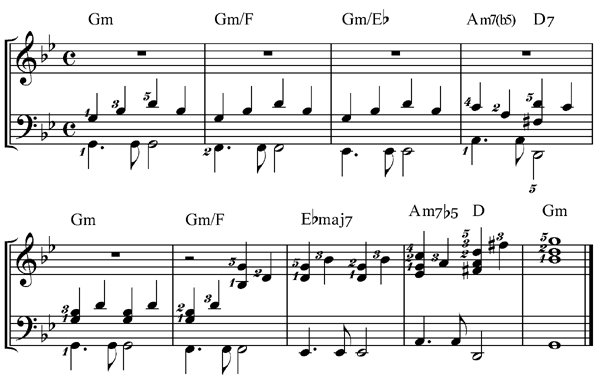

|

|
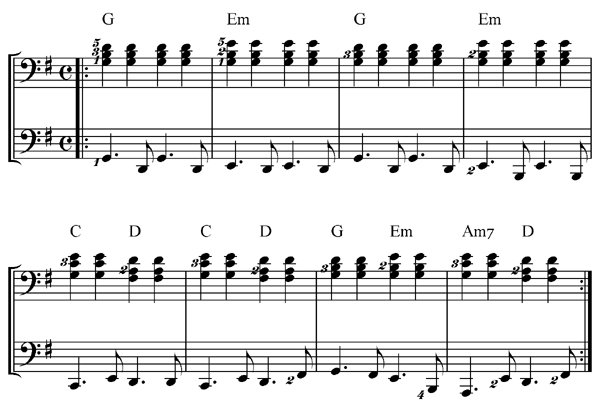
If we tie the quavers over, we get an even more syncopated sound. The crotchet beat has in effect been ‘anticipated’ (pulled forward).

|
The beat map audio plays straight (even) quavers, but note the instruction to 'swing' the quavers in the actual riff.
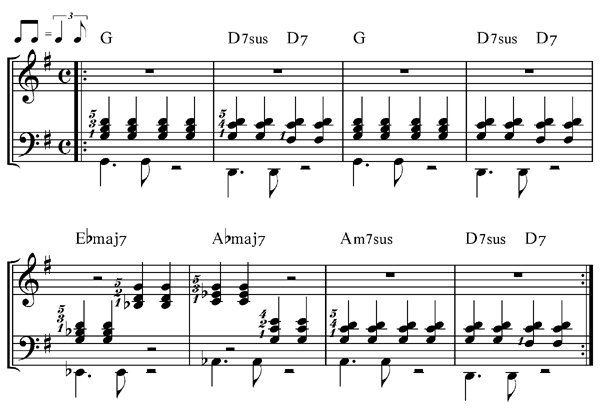

|

|
|
This riff has swing quavers also.
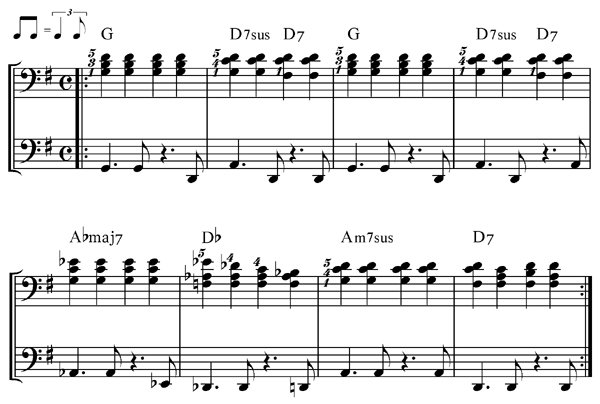
More riffs using the new left hand patterns
Here are some more riffs using these new left hand variations with right hand rhythms we have used before.

|
Notice that, now both hands are playing off the beat, we need to work out the counts for both left and right hands and total them up to get the TLR (together-left-right) analysis.
Here’s a previous riff (slightly adapted) with the new left hand.
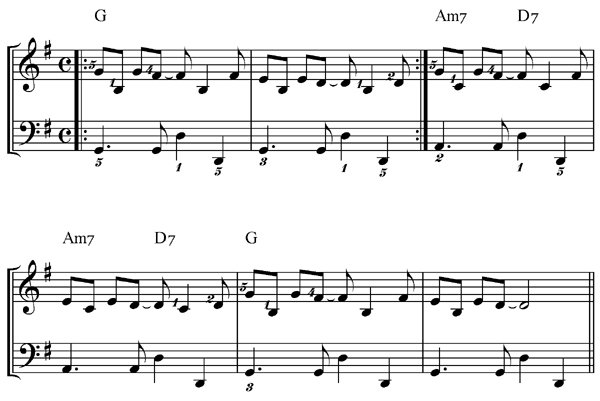
The riff applies a beat pattern to this ‘raw material’:

The next example will show you how useful this idea of ‘applying a pattern to raw material’ is.
Rock;''roll riffs on 1-4-7
Rock’n’roll music is a good style for practicing these two-handed syncopated beat and rhythm patterns because it often uses the same pattern right the way round the chord sequence.
The fifth beat pattern in this module has a classic rock’n’roll rhythm in the left hand (bass). Here’s the original.

|
For now, let’s concentrate just on the bass:

Practise counting and clapping the rhythm.
You might recognise this catchy and useful rhythm better if we count eight quavers to a bar instead of four crotchets. Our count will then look like this:

Count this out loud, stressing the counts with taps on them.

Clap along, and tap you foot an even four to the bar if you possibly can.
The rhythm might be clearer still if you count how many quavers each beat is worth:

The classic rock’n’roll version of this beat and rhythm pattern is as follows.
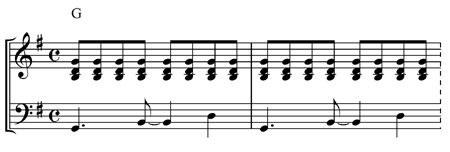
If you think that sounds a bit heavy, drop the right hand quaver chord where the left hand is playing and play to this beat map.

|
You ‘apply the beat and rhythm pattern’ to the ‘raw material’ (the two-handed G chord in the example above) and get this:
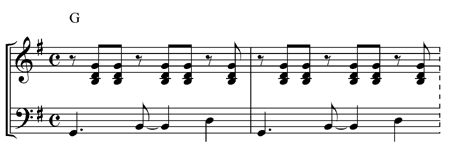
The left hand notes are the chord tones of a simple root position triad. (If you have studied the Musicarta Pyramids Variation series, you will know this as a Basic Music-making Position, or ‘play one, miss one, play one, miss one, play one’ chord.) This left hand is also part of ‘the pattern’.
Now ‘apply the pattern’ to this new harmonic ‘raw material' (chord sequence):
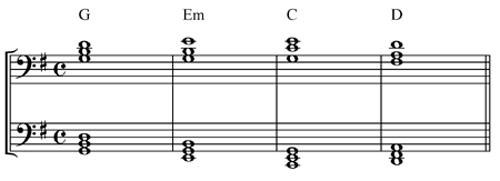
You break up the left hand chords and play the bottom, middle, top notes on the quaver counts:
1 2 3 4 5 6 7 8
(1 2 3 1 2 3 1 2)
... and play right hand chords on any quaver counts where the left hand isn’t playing.
Your performance should sound like this:
The music MS is at the bottom of the page, but try to play the riff without it first.
Filling the quaver eight slot
In rock'n'roll riffs, quavers seven and eight in the left hand are often filled with little tunes that approach the next bass note.
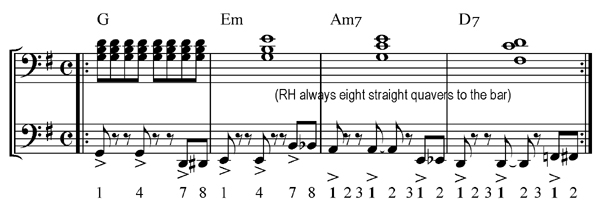
Here the audio track of the riff.
- SIDETRACK!
Here's a slowed-down study to help you get the bass line. Notice that:
- There’s a left hand run-in (down from D);
- The left hand (bass) arrives at the the new bass note via two semitone steps;
- The right hand plays the chords an octave higher;
- The whole study plays to this rhythm:

Copy the audio file:
- BACK ON TRACK!
-
NOTE The familiar-sounding groups of chords in the last two examples are ‘I-vi-IV-V’ (“one, six, four, five”) and ‘I-vi-ii-V’ (“one, six, two, five”) chord progressions. If you would like to learn more about harmony in popular music and naming chords with Roman numerals, take a look at the Musicarta Chord Progressions lesson series.
Filling the quaver six slot
The last beat and rhythm riff in this module is the most advanced. Follow the build-up method, tapping each hand separately, counting out loud and using the TLR analysis.
Rehearse the right hand first. Tap out the following pattern.

|
Rehearse the left hand. Note that the left hand’s pattern is not the same as the right hand above.

|
We are going to make a New Orleans-style piano riff by combining the left and right hands, as follows:

|
Your tapping needs to be very secure before you add in the notes. The raw material is this 12-bar chord progression in D.

Here’s the audio file. Note that slowed-down practice segments follow.
Here is the pattern in D, with a slowed-down audio for practising.
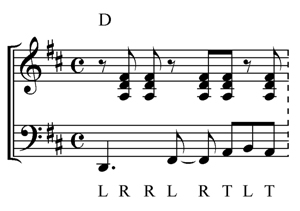
|
You see how the four notes in the left hand chord are played to the rhythm. This is part of 'the pattern', as before - one of the things you 'apply to the material'.
The slash-and-dot sign:
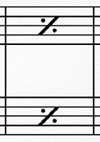
...means ‘play the same as in the previous bar’, so you repeat the pattern three times until you get to the G chord (bar 5), where you ‘play the pattern in G’:
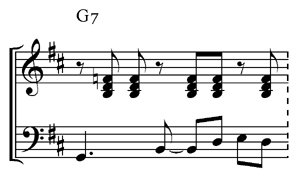
|
The slash-and-dot sign says to repeat that, then back to D for two patterns. When you get to bar 9, you play the pattern in A:
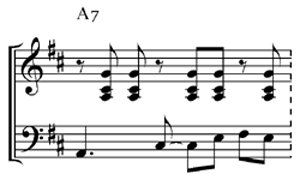
|
...then back for two patterns in D.
Here is this 12-bar chord sequence in a table.
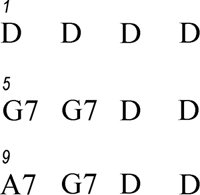
These examples show why a rhythm-pattern approach to popular music is so effective.
Rhythmic patterns, which are easy to generate, themselves suggest attractive riffs. Then you 'apply' the pattern to a hand position (like the Basic Music-making Position/BMP) and a chord sequence (like the twelve-bar chord sequence used here) to get a ready-made performance.
In addition, practising the repeating rhythmic patterns in your favourite popular music on their own speeds up the learning process.
Solutions
Here is the MS of the riff referred to earlier:

This page is one of Musicarta.com’s many free piano lessons online. Click up to the Musicarta home page for an overview of the site and use the tabs on the navbar to access the various section directory pages.
This module is one of Musicarta’s Beat and Rhythm pages. Click up to the Musicarta Beat and Rhythm directory page here to see what else in available to help you add winning rhythms to all your keyboard material.
|
|
Get an overview of Musicarta in manageable monthly slices – and keep up to date with new postings.
Read all about it on the Musicarta Newsletter page. The Musicarta News - regular encouragement to learn and progress! Or – get the Musicarta RSS feed. [What’s that?] |
Thanks for visiting MUSICARTA! Come back soon!
|
|
|
|
BEAT AND RHYTHM
|
PUBLICATIONS
exciting digital
home study packs!
BEAT AND RHYTHM
WORKBOOK


12-BAR PIANO
STYLES WORKBOOK


MUSICARTA MODES
WORKBOOK

MUSICARTA EASY
PIANO STYLE

CANON PROJECT

VARIATIONS
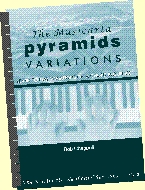
KEY CHORDS VOL.1




YouTube playlists
|
Piano lessons? and keep Musicarta
|






